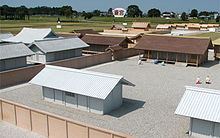 | ||
Saikū (斎宮), also known as "Itsukinomiya" (いつきのみや), was a village located approximately 10 kilometers north-west of Ise Shrine, arguably the most significant Shinto shrine in Japan. Sometimes referred to as the Bamboo Palace, Saikū served as the palace and public offices of the Saiō, an unmarried Imperial princess who served at Ise Shrine on behalf of the emperor from the Asuka period to the Nanboku-chō period of Japan. After the collapse of the Saiō system, Saikū reverted to a rice-farming village that currently exists as a part of Meiwa Town, Mie Prefecture.
Contents
- Map of Saiku Meiwa Taki District Mie Prefecture 515 0321 Japan
- Saik site layout
- Saiks Golden Period
- Saik today
- References
Map of Saiku, Meiwa, Taki District, Mie Prefecture 515-0321, Japan
Saikū site layout
The ancient Saikū site measures 2 kilometres from east to west, 700 metres from north to south and covers a total area of 137 hectares, making it one of the largest historical sites in Japan. Sections of the eastern administrative district of the site have already been excavated and working is currently being carried out in the site's central area.
The town was built on a grid structure based on Chinese traditions and consisted of several large blocks of 120 metres in length, surrounded by high wooden walls. Inside each block were buildings of varying size and purpose, built of Japanese cypress in the method of the day, using interlocking blocks of wood to hold the structure together. The buildings were rectangular in shape and built on poles dug into the ground, with a floor raised up to a meter from the ground. Some blocks contained a small well from which to draw water, or shrines or structures for food storage.
Saikū's Golden Period
Saikū reached its peak from the late Nara period to the early Heian period. Many buildings and relics that date from this period have been found. Buildings that date from this time are of the Shinden-zukuri style and were made of cedar and Japanese cypress and were constructed by interlocking wooden beams without the use of nails.
Saikū today
While digging foundations for new housing in 1970 in the Saikū area, a large Haniwa horse was found, one of the largest found in Japan. The housing construction was halted and excavations began, confirming the site of the ancient Saikū town. Saikū Historical Museum now stands on the site of the original discovery.
Each year further excavations take place on a relatively small scale, with much of the Saikū site still untouched. As the ancient buildings were made of wood, which has long since disappeared, and the site was redeveloped several times over its long history, excavations can reveal several generations of buildings whose foundations must be matched together to form a view of the town's layout. Most focus is given to the early Heian period, when the town was at its peak in size and influence.
In addition to the museum, a reconstructed Heian period residence, known as Itsukinomiya Hall of Historical Experience, has been built next to Saikū train station. Itsukinomiya Hall is not a restoration of a former building, but a reconstruction based on existing Shinden-zukuri buildings elsewhere in Japan.
